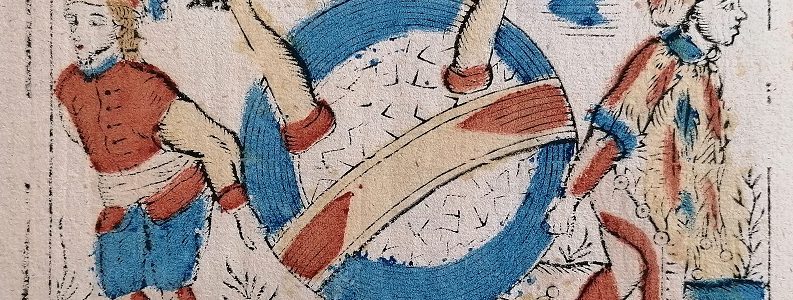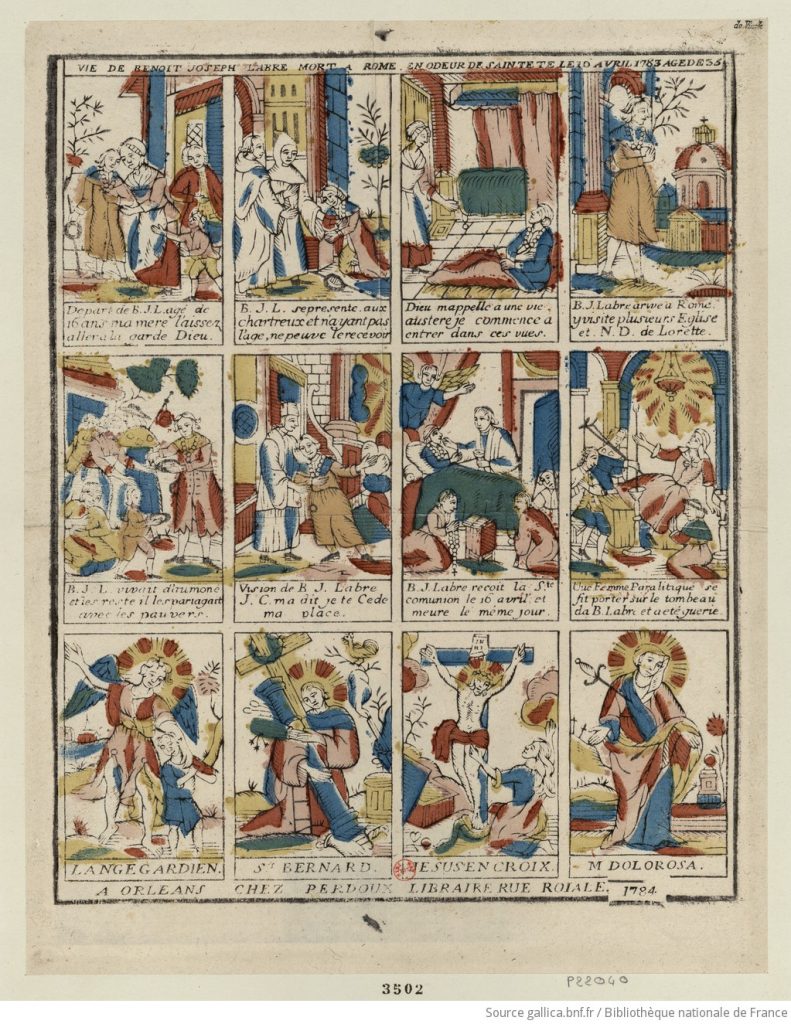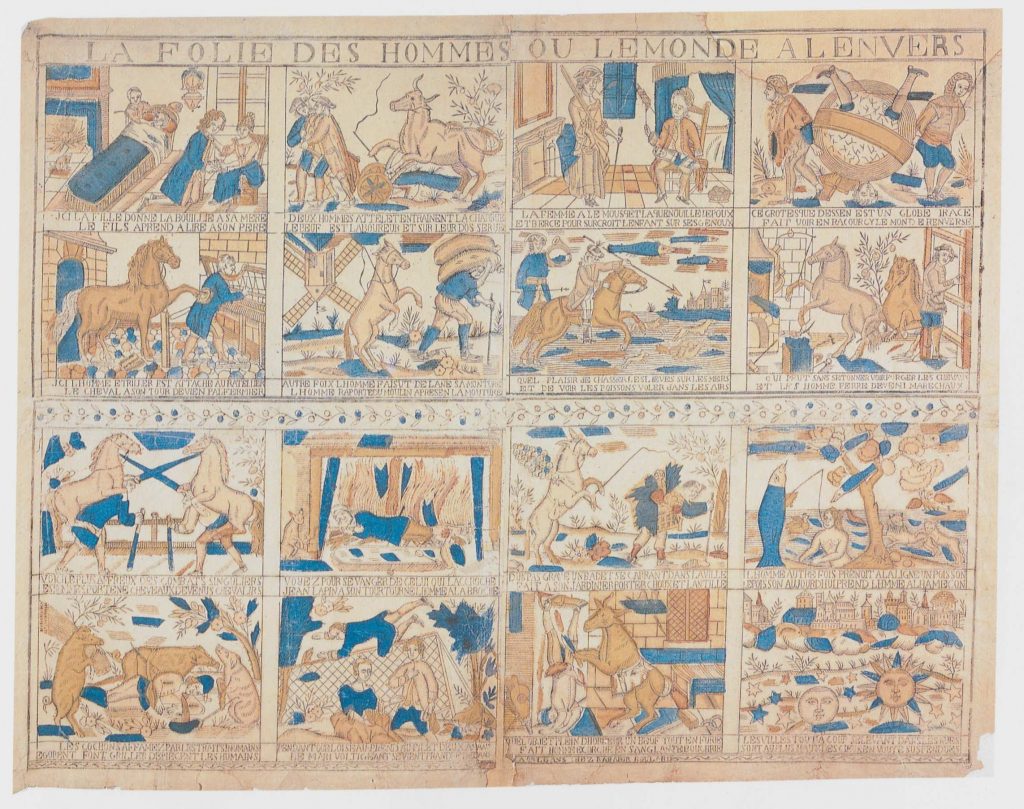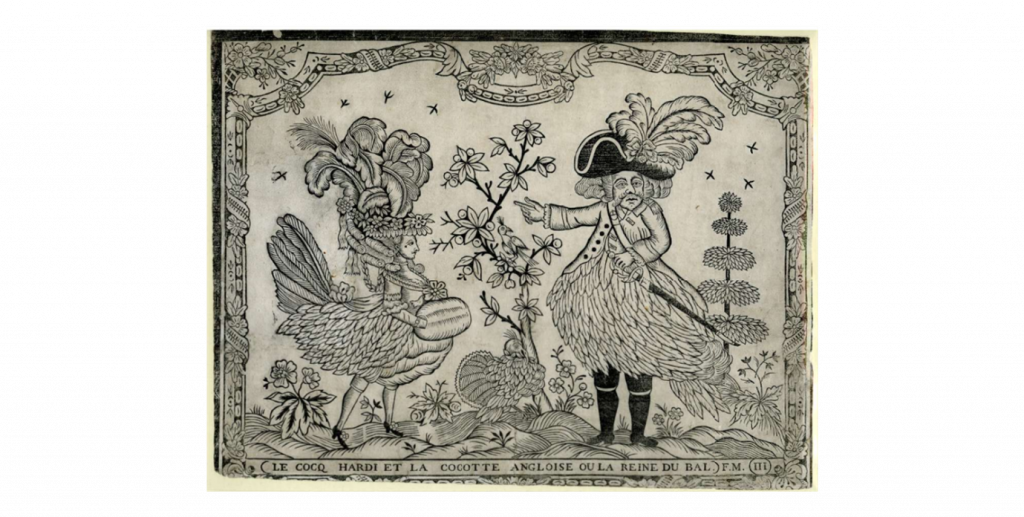
The world turned upside down: popular literature in eighteenth-century Orléans
The University Library has recently acquired, with the generous support of the Friends of the National Libraries, a unique piece of eighteenth-century satirical French printing presenting the popular concept of the ‘world turned upside down’. This is an exceptional survival of large format colour printing from Orléans, designed to be used as decoration within the home and expressing gently satirical concepts of society in the years just before the French Revolution; half of the whole is shown above. It survives on a composite sheet of paper almost 1.5 metres long, woodblock printed in four sections and pasted together. The images are charmingly simple, using four colours printed over a line drawing with each of the sixteen square sections measuring approximately 12x18cm. The total printed area measures 30x149cm, with the overall size of the sheet being 35x160cm.

The sheet was printed to be used in a wooden frieze above a fireplace or as a decoration around a bed frame. The title is printed on the first section, with the illustrations comprising four sets of four images with captions below explaining the content of each image. These include a fish catching a man on a rod; a son teaching his father to read; a hare turning the spit upon which a man is roasting. The satire presents the well-established concept of the world turned upside down, but without presenting a serious challenge to the hierarchy of society.

Perdoux worked in Orléans, a leading centre for the production of printed fabrics and papers on a grand scale.1 He set up his own print shop in 1771, and from 1779 is recorded as producer of wallpapers and popular prints, becoming probably the leading printer of the latter years of the eighteenth century in this provincial centre.2 Auguste Martin’s bibliography of Orléanais popular art suggests that the majority of his surviving single sheet works are on religious subjects, and in smaller formats, which may have been more likely to survive.3 Only a handful of these larger format items are known; they were frequently used as decoration around fireplaces and simply disposed of in the fire when soot rendered them too dirty to read. These items appear very occasionally on the market, and the University Library was delighted to be able to acquire this example. The vendor from whom it was purchased suggests that it was a proof copy, which explains its survival in such outstanding condition.
Perdoux’s work as producer of papier dominoté – printed with a woodblock pattern, often repeating, and coloured by hand – is recorded in up to 500 different designs.4 His smaller format prints on religious subjects survive in the Bibliothèque Nationale and several regional collections, such as the Vie de Benoit Joseph Labre mort a Rome …. le 16 Avril 1793 which displays the same simple style of illustration as the Folie des hommes. This may have been an effect of the need to avoid excessive detail in imagery which was going to be overprinted in colour, as he also produced a more detailed black and white woodcut at the same date, Le coq hardi et la cocotte angloise, satirising the fashions of the 1770s.

Perdoux employed several different engravers, including François Michel whose initials appear on the Folie des hommes, Vie de Benoit Joseph Labre and six others produced for Perdoux. His son in law Robert-Frederic Huet-Perdoux took over the business in 1805 and reprinted several of the elder Perdoux’s blocks, including a Lamb of God with the initials “F.M. 1784” at the foot presumably also being the work of François Michel. This re-use of illustrative blocks was common, with another extremely prolific Orléanais printer, Michel Rabier-Boulard, re-printing the Folie des hommes some 30 years later in a different layout and titling. Both printings of the work use the very typical muted red, blue and yellows of prints of the period, with most surviving examples having the same colour palette. Simon Beattie illustrates similar works by the slightly later printer Jean-Baptiste Letourmy in this blog post.

The University Library has outstanding holdings of colour printed material, both from our historic core collections and more recently from the exceptional collection formed by Norman Waddleton in the late twentieth century. Waddleton’s interest lay not in the subject matter of each book but in the changing techniques of colour printing and as such his collecting was extremely wide ranging in date and geographical origin. This resulted in a uniquely important resource for the history of printing technology, and also brought material the Library would not receive under legal deposit, ranging from a 1488 Sphaera mundi to 1979’s Big Strawberry Book of Astronomy, and from nineteenth-century German architecture to a Javanese work on hunting.
While the Library’s main business is books, we hold many other forms of printed material which convey information for education and entertainment. Other single-sided materials include around 1000 unbound broadsides starting with a 1505 Proclamation of the Coin: designed to be ephemeral, broadsides developed as an early form of street literature which could be produced quickly and cheaply to spread news and official information. The broadside ballad was an extremely popular way to share popular songs, with around 16,000 examples preserved in the Library’s Madden Ballads collection from a huge variety of provincial printers. A specifically Spanish form of broadside, also highly illustrated, is the woodblock printed Aleluya, an early type of cartoon strip. From 100 years after the Folie des Hommes we hold a much more pointedly political set of caricatures relating to the Franco-Prussian war and another recent Rare Books acquisition, the Panorama of the Franco-Prussian War printed by satirist Percy Cruikshank. The Library has extensive holdings of posters relating to student and University activities in Cambridge as well as wider political events, dating back to the early nineteenth century, and continues to collect these as a snapshot of current life in the city. We welcome any contributions: please send them to the Rare Books Department.
- https://webmuseo.com/ws/musee-historique-archeologique-orleanais/app/collection/expo/14 ↩︎
- The interplay between Parisian printers and those of the provincial centres of Orléans, Le Mans and Alençon is discussed in Annie Duprat, ‘Provinces-Paris, ou Paris-provinces? Iconographie et revolution francaise’, Annales historiques de la Révolution française , Octobre/décembre 2002, pp. 9-27. ↩︎
- Auguste Martin, L’imagerie Orléanaise (Paris: Editions duchartre & van Buggenhout, 1928) ↩︎
- https://www.memo-roanne.fr/article/domino-dominote-dominotier-dominoterie-1 ↩︎
- Marseille, MuCEM https://www.photo.rmn.fr/archive/03-000376-2C6NU047SWVB.html This image of the object taken from L’imagerie Populaire française I: Gravures en taille-douce et en taille d’épargne (Paris: Editions de la reunion des musées nationaux, 1990) no. 141a. ↩︎
